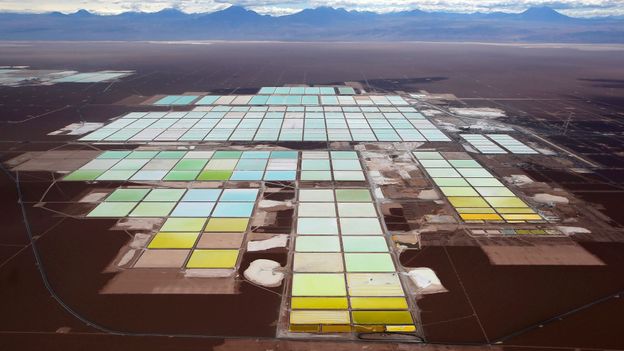There’s a global hunt for lithium to power our devices and electric vehicles. In the latest of our photographic series Anthropo-Scene, we explore the distinctive terrain where the stuff is mined.Beneath the screen that you are reading this on, there could be the distilled essence of a salt plain. Millions of years ago, volcanoes deposited minerals over vast tracts of South America. Later, water leached through the rock to form massive lakes. Cycles of evaporation and deposition followed, leaving vast plains of salt behind – infused with one of the world’s most sought-after minerals: lithium. With the rapid rise in battery usage in electronic devices and electric cars, the demand for lithium and other constituent materials is accelerating. As BBC Future has previously reported, it is enabling mining companies to look in new places, such as the deep ocean or in previously exploited mines, and has prompted scientists to seek alternative battery technology. But our focus today is how lithium is changing the fortunes – and specifically, the landscapes – of those countries that have it in abundance. In Bolivia and Chile, the high tonnage of lithium embedded in the salt plains has given rise to massive facilities. From the air, the evaporation pools associated with the mineral’s extraction dot the landscape like colours in a painter’s palette. In this edition of our photography series Anthropo-Scene, we explore these places, whose striking features have inspired various artists, writers and architects. You might also like: Our visual tour begins in the salt flats of South America, which hold hundreds of millions of tonnes of lithium (Credit: Martin Bernetti/Getty Images)In the Salinas Grandes of Argentina, indigenous people see natural pools as “eyes” with spiritual meaning (Credit: Michael Robinson Chavez/Getty Images)But politicians and companies also see the huge economic value in the salt flats – even if it has yet to be fully exploited (Credit: Aozar Raldes/Getty Images)The Salar de Uyuni salt flat in Bolivia holds what is perhaps the world’s biggest single deposit (Credit: Pablo Cozzaglio/Getty Images)Brine is pumped to the surface and evaporated to concentrate minerals. It’s then filtered and chemically treated to extract the lithium (Credit: Pablo Cozzaglio/Getty Images)Meanwhile, places like the Sociedad Quimica Mineral (SQM) lithium mine have helped Chile to become one of the world’s primary producers (Credit: Alamy)The SQM mine on the Salar de Atacama rivals Bolivia’s as one of the world’s largest lithium deposits (Credit: Alamy)A wider view of Chile’s brine pools. It can take more than a year to maximise the lithium concentration by this evaporation method (Credit: Ivan Alvarado/Reuters)A truck drives between the brine pools in Chile’s Atacama desert (Credit: Oliver Llaneza Hesse/Getty Images)In Germany, lithium is instead mined from zinnwaldite, a silicate mineral. A small deposit by global standards, but big for Europe (Credit: Sean Gallup/Getty Images)The Eti Mine Works in Turkey, where lithium is extracted from the waste of boron production (Credit: Ali Atmaca/ Getty Images)Turkey’s production is unlikely to be a major lithium source, but it represents one of several efforts to find alternative reserves (Credit: Ali Atmaca/Getty Images)Lithium demand will likely follow the growing need for batteries, like these ones for cars at a factory in China (Credit: Getty Images)As the world moves to more electric cars and other battery-operated tech, what new landscapes might this create? (Credit: Tan Yunfeng/Getty Images)


